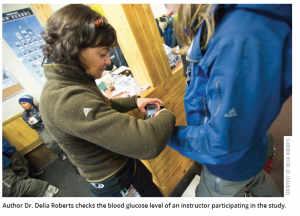Nutrition improves energy levels, injury rates and outlook on work and life! Delia Roberts, the author of the Fit for Snow program, recently contributed an article to the Journal of Professional Snowsports Instruction, focusing on connection between nutrition and injury rates, with some appropriate and relatively easy to integrate tips for ski industry staff.
Read the full article NUTRITION FOR INSTRUCTORS: A key to fewer injuries and more fun.
Through Delia’s extensive research, she has identified that educating instructors on how to manage their blood sugar levels during the day consistently lowers injury rates by approximately 40 percent. The data also indicates that 70 percent of injuries occur more than three hours from the last snack or meal. The following are some excerpts of the article. We encourage you to share the full article with all ski area staff that ski or snowboard as part of their job (instructors, patrol, lift operations and more).
The Research: WHY YOU SHOULD MAXIMIZE YOUR NUTRITION ON THE SLOPES
- Eating a diet that stabilizes blood sugar improves reaction time, decision-making, and mood in snowsport instructors.

- 70 percent of injuries can be attributed to fluctuations in blood sugar slowing reflexes, lowering vigilance and impairing risk assessment.
- High intensity, powerful, strong movements use carbohydrates as fuels.
- Consuming simple sugars, such as soft drinks, granola bars, sweetened yogurt, sweet baked goods, rice, or potatoes at rest will result in high levels of insulin, and a drop in blood sugar.
- Combining whole grain carbohydrates, such as unsweetened whole grain breads and cereals and whole fruits and vegetables with a little protein and fat provides the right amount of energy to be released at the right time for best physical and mental performance.
- If the fat content exceeds 30 percent of calories provided in the meal, it will delay digestion for too long to meet energy needs while skiing and snowboarding.
Where to start:
Try switching out your high sugar, high fat breakfast and lunch for more frequent, smaller servings of food that will provide you with exactly the right energy at the right time and you’ll not only find yourself performing at your best all season long, you’ll enjoy it more as well.
Start by reducing the amount of sugar in your diet; reaching instead for complex carbs that are less processed, higher in fiber, and slower to digest. Have slices of orange or other whole fruits with breakfast to capture all the goodness of the vitamins and minerals. And because you have to digest the fiber of the whole fruit, the sugars will be released slowly over the next hour or so, rather than all at once, which is what happens even with unsweetened “natural” juice.
Choose whole grain toast over white bread, with a smear of peanut butter and banana or apple slices instead of jam. Reach for plain Greek yogurt or cottage cheese with chopped fruit instead of high sugar flavored products. Adding either a little fat, some fiber, or protein will slow down digestion and the rate of uptake of the sugars in the food. Top it off with a sprinkle of hemp hearts, chia seed, fresh ground flax or a few chopped nuts to add heart healthy omega 3 fats and fibre!
Plan on smaller more frequent meals, consuming half your normal breakfast when you get up, and half 2-3 hours later. Do the same with lunch and encourage your guests to follow suit. They’ll have a much better experience if they stabilize their blood sugar too! Carry snacks like a few nuts mixed with high fiber cold cereal and a little dried fruit, or power muffins or bars with less than 30 percent of calories from fat (for digestibility) and at least one gram of fiber for every 5 grams of sugar.
For more information on Fit for Snow and Delia Roberts, please visit:
- Read the full article: NUTRITION FOR INSTRUCTORS: A key to fewer injuries and more fun.
- Follow on facebook: facebook.com/FitForSnow
- Website: selkirk.ca/fitforsnow
- email: fit.for.snow@gmail.com
What’s your plan to improve the health and nutrition of your staff?
- Take time in morning meetings to discuss these nutrition findings and tips. Ask the staff for their ideas on maintaining their nutrition on the slopes.
- See more Ski Area employee safety tools and resources HERE.
- Do you have a great success story? We’re looking for great stories to share and your ideas to improving the health and safety of ski industry employees. Contact Cynthia at marketing@cwsaa.org

